A Tribute to the Adventuresome Life of Wild Bill Buckles
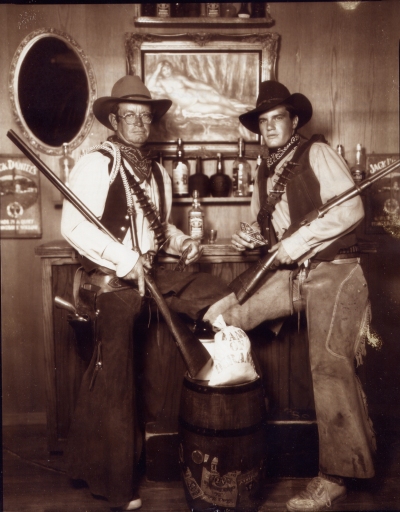
My poem, That Unconquerable Spirit, written for my brother in 1968, went online on my, In God's Design, poetry website in 2009.
Shortly afterward, I was reviewing my Grotto research correspondence for another story, when by chance, I came upon a forgotten 1973 letter I had written describing my brother's years in Alaska and the effect it had upon his future life. It was his fearless determination and his unrelenting courage in pursuing his goals in life that inspired the poem I wrote about him, which I will share at the end of this story.
It's a poem that could also have been written about Rev. Edward Sorin, CSC, founder of the University of Notre Dame, who had his own fearless faith and unrelenting courage in pursuing his mission in life. He crossed an ocean to realize his dream of building a college in a wilderness. His example, and his unconquerable spirit, continues to inspire countless others to follow their dreams.
The letter, mentioned above, was written to an orderly at Holy Cross House—the Retirement Home for priests on the campus of Notre Dame—shortly after my brother returned from Alaska and decided to come home to stay. In it, I shared with him some of my brother's Alaskan adventures while they were still fresh in my mind, as more evidence of that old truism: Alaska, land of the individual and other endangered species. It was finding that letter, written 36 years ago, that inspired me to share my brother's story.
John Dougherty, also a free spirit, often told me of his motorcycle adventures which reminded me of my brother during the years I wrote to him when he was in the service in Alaska. His passion for adventure never diminished even when he decided to return to Indiana. Adventure always awaited him no matter where he happened to be.
Rereading my letter to John, and sharing it again with my brother recently, brought back many memories of days gone by for both of us. Bill asked me for copies of it to share with his two sons, Troy, an Electrical Engineer in Chicago, and Shane, an Electrical Engineer at Lockheed Martin Telecom and a Volunteer Fire Fighter with Inner Canyon Fire Rescue Station in Morrison, Colorado. Inner-Canyon is a full service fire department. They cover everything (structure fires, auto accidents, medical responses and transports as well as forest fires).
The Wild West photograph of my brother Bill, and his son Shane, at the beginning of this story, captures so well, the fun-loving spirit of adventure he and his sons share in common. Shane and his Dad have had many whitewater rafting adventures riding the rapids on Snake River, amid the Teton Mountains, near Jackson Hole, Wyoming.
(Point your mouse on the pictures to see the captions)
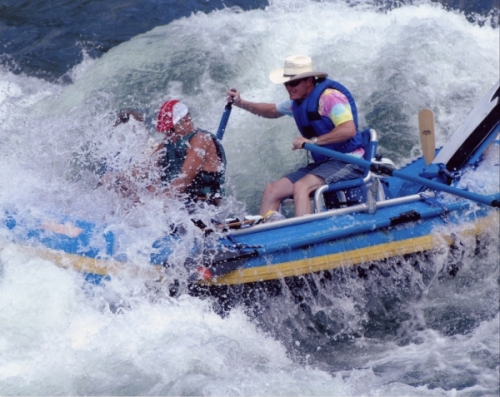
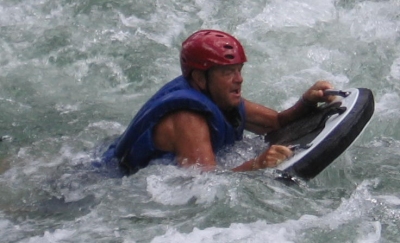
The day before the above pictures were taken a party of five on a river raft hit a submerged tree limb and capsized. Two in the party survived and three were drowned, as these warning signs along the Snake River declare.
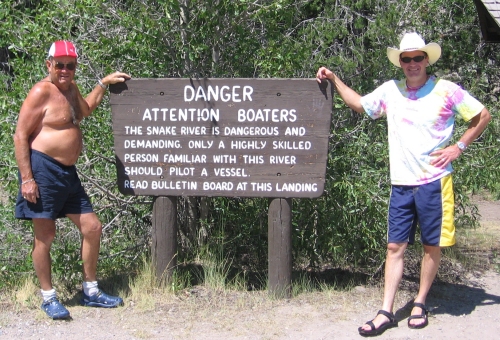
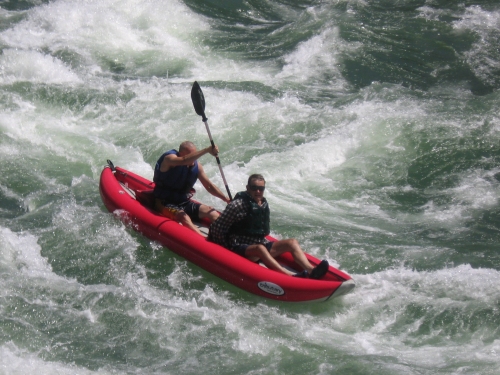
Just moments after the above photograph was taken on another trip to Snake River, a year later, their inflatable plastic canoe hit a submerged branch and they were both dumped in the river. Bill had lost some weight this time, after a brief stay in the hospital, and wasn't his usual vigorous self. He'd been warned that he better not try it and his typical Wild Bill Buckles reply was: If I'm going out of this world, I'm going out in style!
The plastic canoe, referenced above, is typically referred to as a "duckie" in rafting terms. It is made of the same material as a whitewater raft so it can take the punishment of the whitewater.
Shane, as a precaution, had a buddy following them along the bank. Bill was swiftly pulled under and out of sight in the rough water, and later said he just didn't have the strength in his legs to propel himself to the surface. Both Shane and his buddy jumped in after him and pulled him to safety. Bill later said it was the closest he ever came to drowning.
Somewhere I've read: Most people run from danger. A special few run straight at it. Those words came to mind in writing about my brother's Alaskan Adventures and in reading this description of one of Evel Knievel's close calls:
Evel Knievel's daredevil rocket-powered Sky-Cycle motorcycle jump across the mile wide Snake River Canyon in Idaho was the only canyon he was unsuccessful in clearing. He said when he punched the power button, he thought, God, here I come. He crashed, 600 feet below, just a few feet from the swirling waters of the Snake River and walked away with only minor injuries.
I've always said that when the canyon jump comes, if I miss it I'll get somewhere quicker where you're all going someday, Knievel said. And I'll wait for you, because dying is a part of living and none of us is going to get out of here alive. If Mother Nature don't get you, Father Time will. Sure, I was scared. You gotta be an ass not to be scared. But I beat the hell out of death.
His words reminded me, so much, of my brother's lifelong philosophy: No matter what ... Never give up.
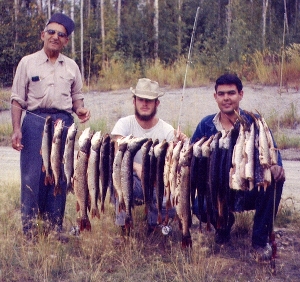
Below is a portion of my letter written to John Dougherty, an orderly I met at Holy Cross House, during the 27 years I visited my priest and Brother friends there. If I hadn't been going through my Grotto research correspondence looking for something else, I would not have remembered writing it. And the rest of my brother's story would not have been written and illustrated with the additional photographs and stories I've included with it.
December 21, 1973
I have a younger brother, much like yourself, venturesome and daring, and I never really understood him completely or fully appreciated his love of adventure until I was inspired to write the enclosed, That Unconquerable Spirit, poem about him in 1968, shortly after he came home from Alaska. In putting his spirit down in words and sharing it, I hope it will also ring true for others who crave a life of adventure.
I've often kidded him that he should have been named Chance or Challenge because he is forever pushing the envelope, testing his limits by reaching beyond himself, looking for new and stimulating experiences.
He is definitely one-of-a-kind. He has been an ocean skin diver, use to fly, parachutes—you name it and he's tried it. Like you, John, he has camped and climbed in the wilds of Alaska. He still carries the picture above, of two of his Alaskan friends, in his wallet. As he has put it: It always takes three, two to fish and one to clean. Two of them caught 36 Northern Pike in an hour and a half at Lake Minchumina, Alaska. And he shared this picture with me to prove it. Wild Bill is in the middle.
While he was in the service, Bill took two and three week leaves from the Army and hitchhiked to Fairbanks, Alaska in 30 degrees below zero weather. From there he caught a C-47 cargo plane to a village in the arctic circle. He stayed at a rooming house, a big cabin with rooms for people traveling through the area. While he was there he helped a Episcopal missionary chop ice and went ice fishing on the arctic ocean with a 100 year old Eskimo woman in 65 degrees below zero weather. He thought he got a great picture of her trying to take a bite out of a fresh Salmon she had just caught, only to find when he had them developed, the film in the camera had frozen right at the point where he took her picture.
He also spent several days in Kotzebue, an Eskimo village in the arctic circle, palling around with the locals who let him drive their dog sleds which was quite an experience. Their cabins and buildings were totally covered with snow in the winter. They had to dig tunnels and carve steps in the snow to find the doorways.
One building—where they showed John Wayne movies to entertain the villagers—was totally covered with multiple feet of snow with only a stove pipe sticking out of the top of it to vent the heat and mark its location. He said the movies were so old that John Wayne was only 18 or 20 years old in them. It was all they could get. And when you put three trappers and 30 Eskimos in their animal skin parkas together the atmosphere in the room can be overpowering.
He explained that the locals fish and hunt all day and when it gets dark they all come out and party half the night. He danced with an Eskimo girl and watched the beautiful Northern Lights which he said were spectacular. They looked like they were touching the ground and the stars and the big dipper looked close enough to grab. He said he has never forgotten the experience and when he returned to the states he thanked his Episcopal missionary friend for his hospitality by sending him some much needed, and very welcomed, tools for their village.
During his time in the army in Alaska, from 1954-1956, he dated a teenage Eskimo girl and walked with her on the Arctic Ocean at 66 degrees below zero. He mushed dogs and snowshoed 12 miles to the Girdwood mine, in 30 degrees below zero weather, for a three day camp out in a mine.
He spent many weekends alone hiking through the wilderness North East of Anchorage so he always carried emergency flares to mark his position in case he got in trouble. One night when he came back from one of his weekend hiking trips he said he unknowingly ended up in the middle of some army night warfare practice. He dug in in a hurry and when he got up the next day the side of the mountain several hundred yards from him was all torn up. Fortunately, he said, he didn't need the emergency flares, but needless to say, it was the last time he came in from that side of the mountain again. He snowshoed on frozen rivers to the mountains, slept outside in 26 degrees below zero weather and soon became the company scout who took guys out on weekends hiking all over North East Anchorage.
In 1956, he took his discharge from the Army in Anchorage and went to work on the Alaskan railroad as a brakeman and fireman. It was a job that also included pulling the moose—they sometimes hit between Anchorage and Fairbanks—off the tracks.
In the summer of 1956, he went to work for the Civil Aeronautics Association doing carpentry repair all over Alaska where he did more fishing. He helped, Kenny Garoth, a trapper, run a trap line and pack in moose meat at Lake Minchumina 90 miles North of Mount McKinley and he gave him moose and bear meat to eat. He also helped some Indians net 200 fish about twice a week. One night they caught 36 Pike, right off the beach, in an hour and a half with a telescopic fishing rod and a Dare Devil lure.
When he was on the Kuskokim River in McGrath a bush pilot flew in one day with a body with no head. A bear evidentally ripped it off while he was in his sleeping bag.
On another occasion he went canoeing and found a ghostly old river steamer paddle boat beached on the shore of Kuskokim River, probably left there during the gold rush days. A lot of freight was brought in that way on river boats. Either they no longer had a use for it, or it wore out and they just ran it aground and left it, with life jackets and equipment still on it.
McGrath, Alaska is in the interior of Alaska and one day he said he flew in with an African American guy. The natives had never seen a black man before. One of the other guys he was with caught a Chu Chee fish there that is only native to Alaska and a couple other places in the world. It fed 20 construction workers.
Taverns were rowdy places and one never knew what might happen. One night, Bill said he saw a trapper lose $1200 in a poker game which was a lot of money in 1956. Gold was $16.00 an ounce then. Now it's $900.00. Trappers would fly into McGrath by tying their Long Johns to a pole on the top of their cabin as a signal to the bush pilots they wanted to be picked up. They would sell their pelts, pay the bush pilot for their return trip, and then drink and gamble till they were broke. It was common to see 50 or 60 beaver pelts stacked on the floor in the back of the tavern.
One day he said there was a big stout Indian gal there. She didn't have any money so she told the bush pilot that Pete Egress at the bar would pay him. So Pete put her to work splitting wood for the next winter. Bill said her name was Salamonya and she called him whiskers because he had a full beard and a handlebar mustache. He said he'd never forget the night two good-sized guys got her drunk and she threw them both in the Kuskokim River.
Many years later during one of his Snake River rafting trips with his son, Shane, he took Bill to the Bucksnort Saloon, a popular Colorado cowboy's bar, pictured below, where the cowboys and the locals of the area meet and the specialty beer is Antler Ale. It's in an expansive mountain valley they call Sphinx Park (named after a sphinx-like rock formation).
It took Bill back to his days in Alaska and he took these pictures of it to remind him of another one-of-a-kind place to remember. Note the tables made of huge wooden spools used to wrap commercial wire cable on, and the messages, dollar bills, business cards and photographs stapled to the walls and ceiling. Rough and ready cowboys wear their six-shooters and hitch their horses outside, also pictured below.
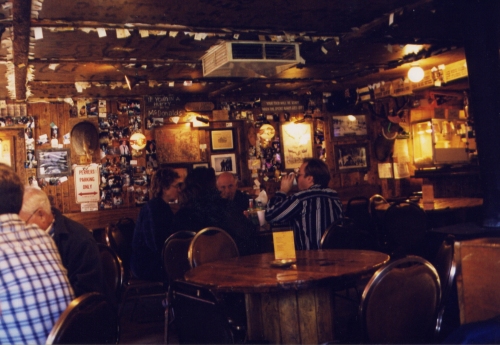
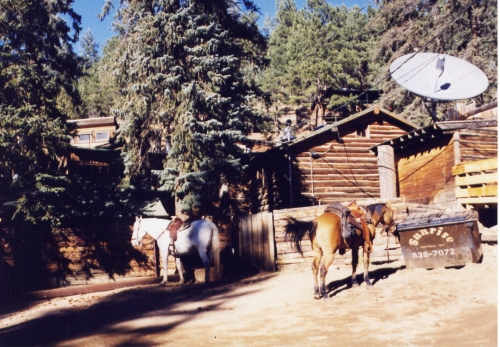
Many a tale Bill has told about the wonderful, friendly, earthy people in Alaska and how open-handed and open-hearted they all were. A very different way of life, he said, from the indifference found in crowded big cities. When he returned to Indiana he had a bit of a time adjusting again, but he has never lost that way he has of always being on the scene helping out when anyone is in need or in trouble.
After his service in the army he returned to Alaska again, with his bride, to live and work there. He and his wife were hearty pioneer stock undaunted by wilderness living or the rough life, and as good-hearted as they come. I always addressed my letters to him to Wild Bill Buckles because it suited him so well and it has stuck with him ever since. We never knew where he would be next.
In one letter he described their trip back to Alaska with their travel trailer on the Alaskan Highway. On one of those steep rugged stretches the refrigerator door flew open and everything not anchored down was strewn all over their trailer. It was one of those Alaskan memories never to be forgotten.
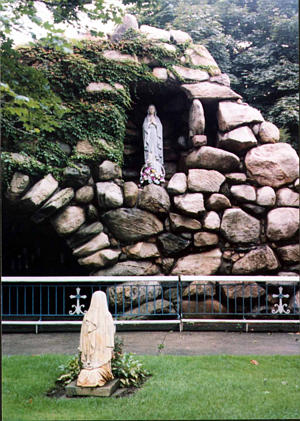
Our father, a small masonry contractor, had completed a replica of Notre Dame's Grotto, at the St. Stanislaus Church in South Bend, the previous year. Working on the Grotto with his Dad was one of my brother's first jobs as an apprentice brick and stone mason before he returned to Alaska. He may now be one of only a few masons still living who have worked on a replica of Notre Dame's Lourdes Grotto in the United States.
Six months after they returned to Alaska, in December of 1963, our father had a heart attack and was in the hospital. We had everyone looking for them but even the Northwest Mounted Police could not trace them.
Unbeknown to us, they had already come back down the Alaskan Highway and were headed into Montana planning to surprise everyone by coming home for Christmas. Arriving in the early morning hours—and finding no one at our parent's home—they traced us to the hospital and walked in still wearing the Eskimo parkas his wife had made for them. My brother was also sporting a neat beard and a handlebar mustache grown while they were in Alaska. A large oil painting of this photograph later graced their A-Frame Alaskan Homestead.
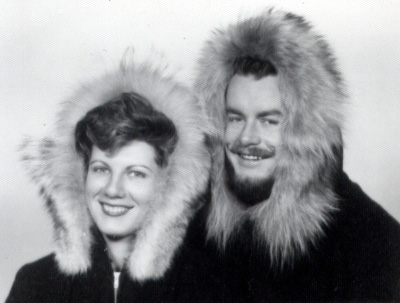
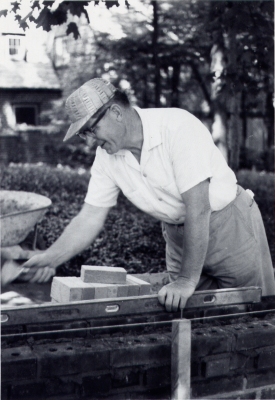 Bill pitched right in and took over the out-of-town masonry job his Dad was working on at the time. He was working on that job when we all received an unexpected call from the hospital that our father was near death. Bill left immediately but his Dad's room was empty by the time he arrived at the hospital. The shock of the news that he had already passed away was a blow softened only by the fact that he had spent a full day with him the day before.
Bill pitched right in and took over the out-of-town masonry job his Dad was working on at the time. He was working on that job when we all received an unexpected call from the hospital that our father was near death. Bill left immediately but his Dad's room was empty by the time he arrived at the hospital. The shock of the news that he had already passed away was a blow softened only by the fact that he had spent a full day with him the day before.
Rev. Sigmund Jankowski, CSC, who commissioned him to build a replica of the Notre Dame Grotto for his parish church, said he was the only mason he could find who was willing to tackle the challenge. William Buckles, Sr. left this world on December 13, 1963, a year after the St. Stanislaus Grotto was completed and shortly after Kennedy's assassination on November 22, 1963. It was one of the last jobs he completed before he passed away at age 68.
In later years, my brother recalled a comment a general contractor on the Notre Dame campus made to him when he hired him: If you're half the man your Dad was we want you working for us.
William Buckles, Sr. came to South Bend to work on the Union Station and stayed to work on the original Notre Dame Stadium built in 1929. He was also a masonry superintendent on the University of Notre Dame campus for many years. A copy of his detailed, illustrated, masonry work manual is now preserved in the University Archives.
He passed away three years after this photograph of him was taken. At his funeral, one of his brick mason friends told me: You know what impressed me about your Dad? I never knew another mason whose white overalls were as clean when he left the job as they were when he started.
I was alone with him in the hospital when the news about Kennedy came over the TV. I will never forget it. Being in the hospital with him shortly before he died was unreal, but hearing the news on television of Kennedy's assassination was even more unreal.
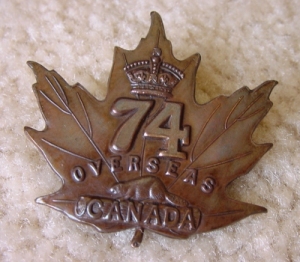
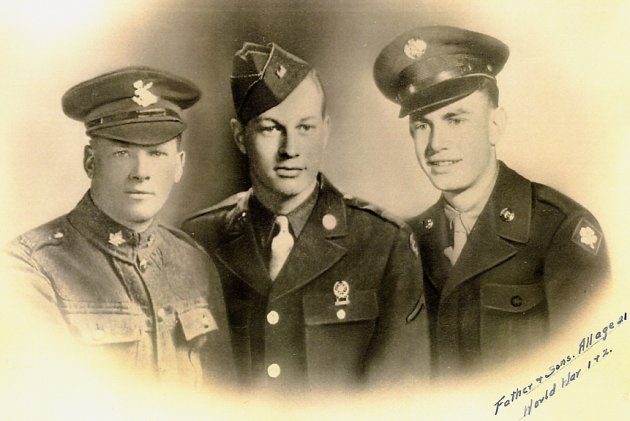
One thing that often comes to mind when I think of my father is the memory of this World War I and II composite photograph of himself in the uniform of the Royal Canadian Mounted Rifles—together with his two sons, Ken and Bill, in U. S. Army uniforms, all at age 21—which always hung in his home office. On the wall above it was a framed World War I poem called, In Flanders Field. Inset in the corner of the poem was a small photograph of one of his brothers in uniform who died at Vimy Ridge and was buried in Flanders Field in World War I.
Our father, who was born in Canada, served in the Royal Canadian Mounted Rifles from April, 1916 until November 7, 1918. The picture above and the poem, In Flanders Field, remained on his office wall all his life. He rarely talked about his war experiences. I found out about them, recently, when I read his trench warfare diaries.
He kept them from the day he went into the service on March 13, 1916 until he was discharged on November 6, 1918. On that day, in his diary he wrote, Discharge 10 a.m. Good bye Army! On November 7, there is written only one word, Home. Below it, faintly visible, (he apparently thought he had erased it) were two more words written upon seeing his father on the Pier when they docked: Much affected. Near the end of his diary, a violet and two four leaf clovers, were pressed between the pages.
He was wounded in, No Man's Land, trying to get a buddy to an aid station (he had already expired). Blood was gushing from his arm and upper body and he could no longer crawl to safety. He said he took a bottle of iodine from his first aid kit and poured the whole bottle into the bullet hole, which might have been the only thing that saved him. He knew he would be an easy target, but desperate, he stood up, and ran instead. And he survived, or I would not be here to tell this story.
Here is the actual entry from his World War I diary that tells the story of that day.
I know now why that poem was always there, to remember his brother—and all those less fortunate—who did not survive. To view a beautifully illustrated version of the In Flanders Field poem and the story behind it click here.Walking across no man's land, stepped on a dead soldier's foot, head popped off. Found a wounded buddy. Put his rifle bayonet in the ground, with the helmet on top. Stooped to help him, was shot in the shoulder. Blood spouting like a fountain. Crawl to a medic. Exhausted stood up, too tired to care if I get shot. Medic's gurney to the ambulance full of wounded Germans. Take a helmet.
9:10 PM Early guard duty, easy time last relief. Hear someone moaning on tracks, go there, hit by train, both arms cut off, smashed head. Carry to medic. 5 AM look for his arms find one.
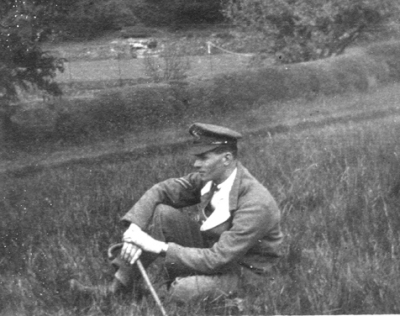
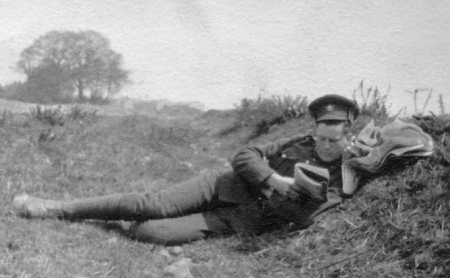
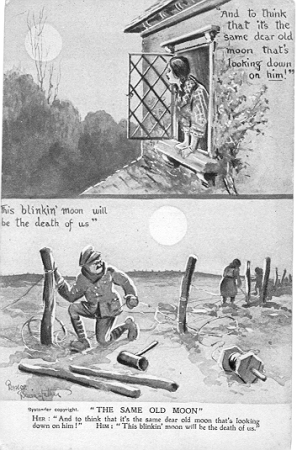
|
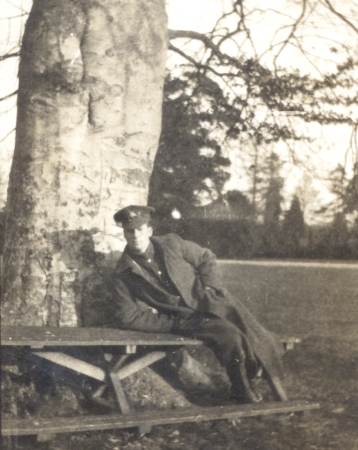
|
| Her: And to think that its the same old moon that's looking down on him! Him: This blinkin moon will be the death of us! | William Buckles, Sr. Convalesing in England |
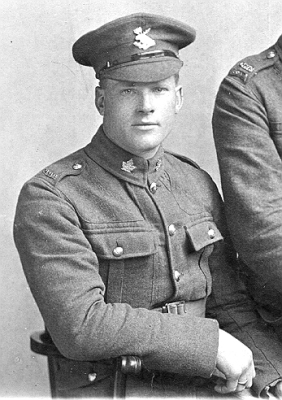 This photograph of Bill Sr. in his WWI uniform has an interesting story to tell. I found this picture, by chance, after I put the composite photograph, above, in this story. Our Dad wore a ruby red ring throughout his life and I never knew the story behind it. I knew he had given it to my brother, Bill, many years ago, because I often saw him wearing it, too.
This photograph of Bill Sr. in his WWI uniform has an interesting story to tell. I found this picture, by chance, after I put the composite photograph, above, in this story. Our Dad wore a ruby red ring throughout his life and I never knew the story behind it. I knew he had given it to my brother, Bill, many years ago, because I often saw him wearing it, too.
Recently, when my brother was in the hospital, I was chatting with his son, Shane, who had just come in from Denver. I was surprised, and pleased, to see him wearing that same Ruby Red ring, which he said was given to him by his father. He told me the story he was told about it and he said he hoped to carry on the tradition.
When I was looking for the photographs I included with the WWI and WWII composite photograph, I found this new one and it looked familiar. When I compared it to the composite photograph, above, it was the same picture except the lower part of the photograph, where his hands were, was missing, whereas in the original they were there. In studying it closely, I'm convinced it is the same neat looking Ruby Red ring. It is gold with a narrow rectangular ruby red gemstone inset in it
All of which, must mean our father must have worn it overseas during WWI. If that ring could talk imagine the stories it could tell. It has passed through three generations yet we will never know its true origin. Somehow, I'd like to believe that it was also given to our father by his father. Perhaps when he went overseas.
A Ruby is a symbol of powerful feelings. It's one of the most valuable gemstones on earth. It symbolizes passionate unbridled love which two people feel for each other. The kind of powerful feelings our father expressed in his WWI dairy in seeing his father on the Pier when he arrived home from the war safely: Much affected.
Sharing the above story, has reminded me of another interesting story related to my father's WWI Trench Warfare Diaries.
When our mother passed away, in 1982, items of interest were divided between their four children. One of those items was a large, attractive silverware box, emptied of its silverware, in which our mother kept those ancient 1" x 3" family photographs taken in the early 1920s. No one else had any interest in them, at the time, so the box of photographs was passed on to me to keep for the rest of the family.
The box stayed on my closet shelf for years unopened. When I went through it one day, years later, I discovered Dad's World I Trench Warfare Diaries, mentioned above, in a small zippered pouch. When I looked at them the first time, the writing was so small that they were sometimes difficult to decipher. But they were fascinating, nonetheless, especially his descriptions of the trench warfare in France.
Years later, I showed them to my brother, Bill, and he borrowed them to read himself. When he returned them he told me he had the two four leaf clovers laminated, in wallet size, to preserve them and he gave them to his two sons—who would be carrying on the Buckles name—as remembrances of the grandfather they never knew.
This past year, when Bill stopped by to leave some photographs to scan for this story, Dad's war diaries came up in our conversation again and Bill told me a story of his own I never knew. My husband, Jack, was also in the Army in the Pacific during World War II. He returned to the bank—where he worked as a messenger boy before he left for the army—and retired as one of their Vice Presidents 40 years later.
Bill, told me, that when he enlisted in the Army and was headed for Alaska, before he left, Jack handed him a newly minted $2 bill and told him: Keep this in your wallet and you'll never go broke. And if you still have it when you get back I'll give you a new one. Bill said he never forgot it. And he pulled them both out to show me, that he still carried them in his wallet after all those years.
He said he hadn't seen them since and he wondered if they still made them. I'd like to give them to my grandchildren, he said, and tell them the same story. I told him that they probably did still have them, if you special ordered them. But you won't have to, I told him, I found a partial packet of them in Jack's dresser drawer when he passed away and I'm sure he'd want you to have them from that same packet. And so, another family tradition has begun.
For those of you who have never seen a newly minted $2.00 bill, here's one from that same packet.

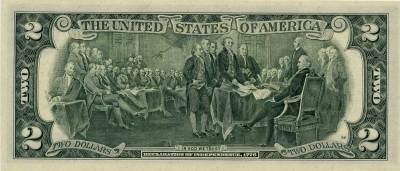
With his Dad gone, and our mother alone, Bill and his wife decided perhaps it was time to settle down and start a family. Although to this day I believe their hearts are still in Alaska, especially my brother, who has always loved an adventuresome, rough and tumble, backwoods kind of living.
When they left Alaska and came home to stay his adventuresome spirit took another turn. He searched for and found six acres of woods—three acres of oak trees and 3 acres of pine trees—which became a perfect spot to build a rustic, all masonry, A-Frame home as a remembrance of his years in Alaska.
Coincidentally, Bill built their home just a half mile from Our Cottage of Content in its woods setting, which we designed and built twenty years earlier in 1952. Both homes were built on land that originally belonged to Sorin less than a mile north of the University of Notre Dame campus.
From that moment on he began capturing a bit of the wilderness life they left in Alaska by creating what can only be called: One Man's Impossible Dream.
The all masonry home he designed and built with his own hands—with exposed barn beams and brick, marble, and fieldstone, inside and out—has a special quality about it. Its natural rustic charm can be maintained with a minimum of care. Like Bill, it's a one-of-kind home. One, he said, he knew he would not be able to afford unless he built it all with his own hands.
After the land was purchased and cleared for building, the groundwork began, via trips from their small home in the city. As their new home began to take shape they purchased a trailer and lived in it until the interior of the house was livable and the exterior stone work progressed from there. It was a labor of love that took my brother 20 years to complete.
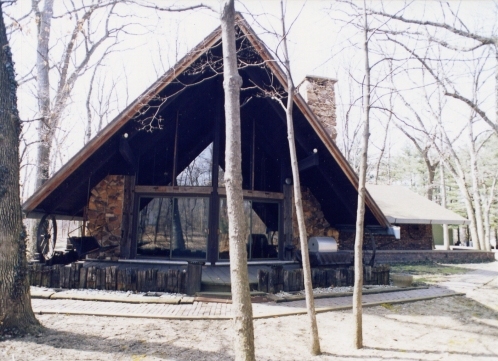
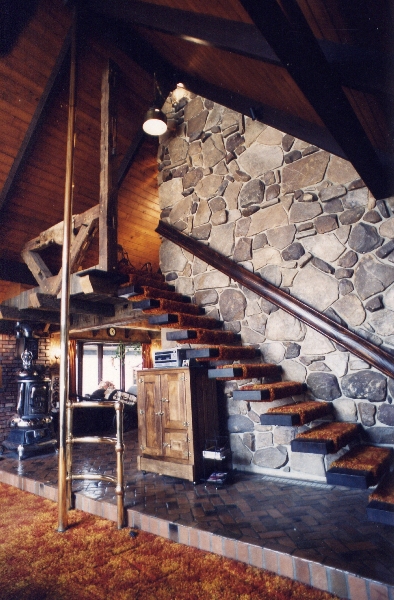
The main supporting interior wall of the living room is rugged Wisconsin Boulders from the floor to the peak of the cathedral ceiling, with a matching walk-in Wisconsin Boulder fireplace and original 14" square hand-hewn barn beams throughout. A suspended stairway, just the steps, pictured above, climbs the floor-to-ceiling interior fieldstone wall to the bedroom loft trimmed with old barn siding.
Near the cantilever stairway is an original antique brass fire pole and guard rail—always polished to perfection—from which their three little ones slid down for breakfast. Bill bought the firepole from a former fire chief, who had it stored in his lake cottage. Chief Cecil McHenry rescued it from the Studebaker fire station before it was demolished.
Behind it against the cantilever stairway, is an original antique ice chest. Hung throughout the house are antique rifles, lamps, and end tables made from old farm implements. Glowing green ship lights and a horse collar Bill made into a mirror greet guests in a hallway entrance. All of them rescued by my brother and made into appealing decorations for their one-of-a kind home.
The huge moose antlers, pictured below, were once attached to the loft stairway railing. They were found near an old cabin Bill was staying in while he was working on a building in a town 200 miles by air from Fairbanks, Alaska. They now decorate Shane's mountain home in Denver. The gun displayed below the antlers is a 45-70 1873 Springfield Rifle.

The boys loft bedroom has the same peaked cathedral ceiling as the living room. For extra rumpus room space, the beds Bill made for the boys fold neatly into the side walls between the rafters and come down on chains for sleeping. An antique desk and an old fashioned wood wall telephone, with a crank on the side to call the operator, grace the landing at the top of the stairway leading to the boy's loft bedroom.
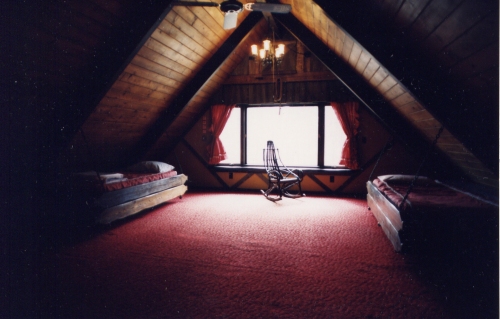
Two bathrooms are walled on two sides with rugged fieldstone of two different types. The boy's tan tile loft bathroom, below, is walled on one side with California Driftwood (not shown in the picture) and the bathroom, below it, on the main floor, is walled in greenish colored Georgia marble. They were designed and tiled by Bill. The sliding doors on both bathrooms were cut down from weathered sliding barn doors, latches and all.
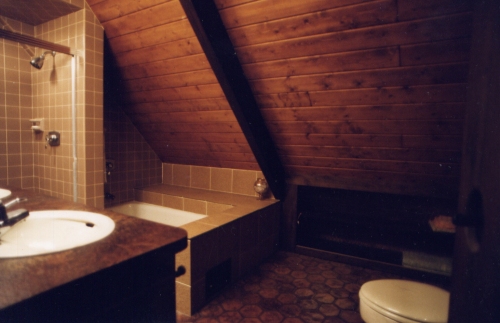

The kitchen and dining area has an indoor barbecue and a full sized original old-fashioned butcher's block, a gift from the Corsons, with the original knives and cleavers. It was rescued from an old time grocery store about to be dismantled and torn down. Next to the kitchen is a handy pantry room for canned goods and food storage. Beside it is a stairway leading to a large basement area, which includes separate laundry, furnace, and utility rooms.
It also has an impressive recreation room area that could be made into an Irish pub for entertaining. It has a wine keg barrel inset in the wall, and an upright piano, ready and waiting to be played. The walls have brick wainscoting below and rough barn paneling above it providing a perfect background for appropriate paintings, or landscape scenes suited to whatever theme appeals to the owner. Adjacent to the recreation room is a third tile guest bathroom, designed and built by Bill, with attractive curved tile corners. Later, when the boys were older and waterbeds were popular, Bill built them a kingsize waterbed, and the recreation room area became a bedroom and bathroom for the boys.
The barn-beamed ceiling of the polished brick floored dining room and kitchen, pictured below, has an antique wood burning stove nearby with gleaming polished silver trim. It was rescued by Bill from a farmer's barn and brought to life again to add its warmth and charm to their homey dining area. Beside the wood burning stove is an antique barn beam auger drill Bill made into a lamp (with the cream colored shade). Also note the antique heavy duty wheel barrow with the blue cushion in front of the kitchen window. Bill fixed it so when the skids are tilted upright to the floor it becomes a roomy padded chair. Shane now has it in his home in Denver and he says it's so comfortable, everyone wants to sit in it.
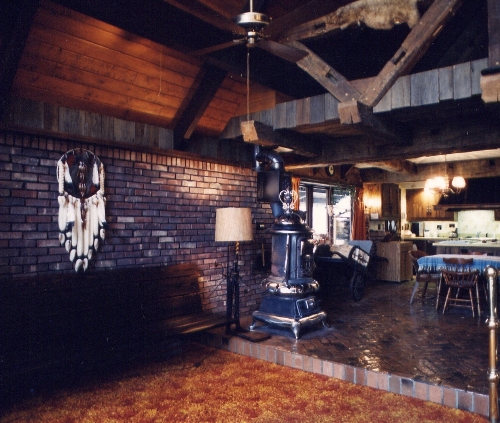
At the top of this same picture, is the loft railing with an animal fur skin draped over it. The moose antlers, pictured earlier, were originally attached to this railing. They were an eye-catching Alaskan accent to the living room and dining space. The unique Dream Catcher above the living room wall bench was purchased at an Indian Reservation on one of their traveling vacations out west. The two bedrooms on the main floor are walled with appealing rose-colored brick.
Most of the built-in cupboards throughout the house, and the long bench below the unique Dream Catcher, pictured above, were also handmade by Bill. The origin of the butcher's block, and the kitchen cupboards—which were custom made by his best friend and crane operator, Ernie Snider—as well as the history of other antiques in his home, are duly noted with brass plaques attached to them. The large round antique dining room table with a Lazy Susan, built by Bill, came later.
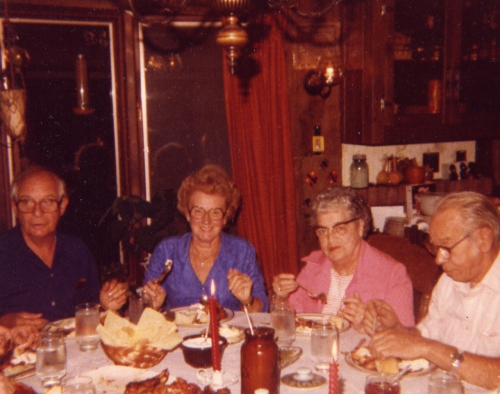
The rustic wood doors next to the Wisconsin Boulder fireplace, pictured below, open to a convenient storage space for firewood. There are matching wood doors at the other end on the outside of the house so that firewood can be replenished without carrying it in the house (another innovation of Bill's). It also has a small old fashioned wood burning stove inset in the fireplace opening to provide additional heat and less heat loss than using the whole fireplace.
Near the stairway, in front of the fireplace is an antique bamboo rocker and beside it a lamp made from an antique fodder chopper. It had a big blade on it to chop corn stalks to feed the cattle. Near it, out of view, is a comfy swinging basket seat for the children which hangs from the ceiling by a bungee cord chain. The wagon wheel chandelier at the top of the photograph was another of Bill's creations.
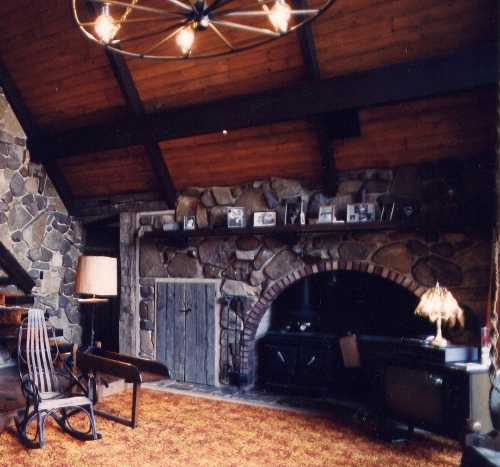
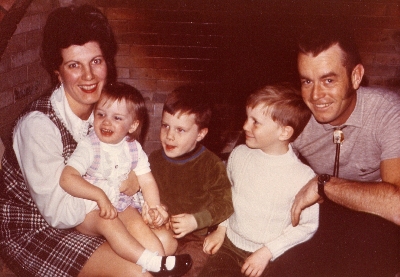
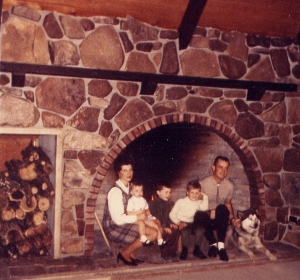
It's a home with a lived-in look. Filled with homey, casual furniture, you don't have to be polite to. Its cozy living room fireplace setting is perfect for yearly Christmastime photographs.
Their first Christmas in their new home included a beautifully decorated 15 foot Christmas Tree with a six inch trunk from a local farmer's farm. It fit beautifully in their cathedral ceiling living room. But Bill was surprised to find the only way he could remove it was to cut it into pieces with a chain saw. Easy to get in but a big job to get out.
All of it, my brother's ideas and handiwork. He designed and built their A-Frame home as he went along with just a few of his own blueprints and a framing plan. After almost four years of concentrated effort—assisted along the way, when needed, by the extra helping hands of his family and good friends—they moved in. He finished the exterior brick walls and the mammoth exterior fireplace chimney, with its 4000 lb chimney cap the next year, completing the numerous interior additions and refinements at a steady pace over a span of 20 years.
Even the huge fireplace chimney and its mammoth concrete chimney cap have a story to tell. The crane operator, Ernie Snider, who was hired to position the boulders in the St. Stanislaus Grotto, became one of Bill's best friends and later brought his crane to help him place the huge concrete cap on the chimney when he finished it.
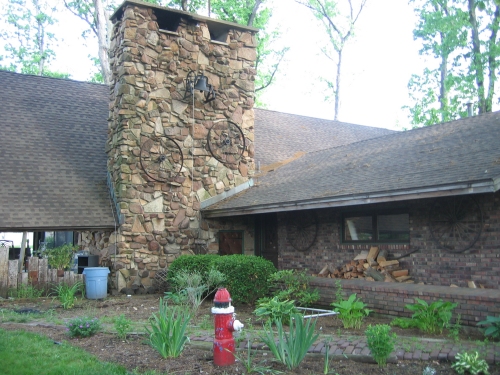
Our son, Greg, who was 12 years old at the time, was there with us to watch the event. He never forgot Bill's friend, Ernie, who let him get up in the cab of the crane and operate it.
The outside chimney, the fireplace, and the cantilever stairway wall, are all made of Wisconsin Boulders. Hoisting the heavy boulders to the upper portion of the chimney to be mortared in—before the finished cap could be put in place—was a feat in itself. To this venture, my brother added this interesting story.
He said he tied a huge knot in the heavy rope to which a bucket of large boulders was attached, and his boys would take turns sitting on the knot to add extra weight, making it easier to raise the stones on a pulley to the different levels of the scaffold where their Dad was working. When the chimney was finished Bill celebrated the event by finding a hiding place for a time capsule containing family pictures and historical information pertaining to the building of the house.
A low decorative wall and a brick pathway bordering it, leading to the entrance door, followed the completion of the chimney. The same brick pathway, made with 11,000 antique paving bricks—salvaged from Monroe street when it was paved—circles the whole house from the entrance doorway, around the porch outside the living room floor to ceiling sliding glass doors, to the kitchen doorway, graced with a picture perfect fir tree. Uninterrupted, it continues past the view from the loft bedroom window behind the house until it returns to the garage and it's entryway origin.
Used railroad ties cut in varied sizes support the porch deck and add a decorative accent as a porch railing. For a better view of the decorative wall, the original walkway, and the porch railroad ties, scroll back to the earlier A-Frame photograph of the front of the house titled, Wild Bill's Alaskan Homestead.
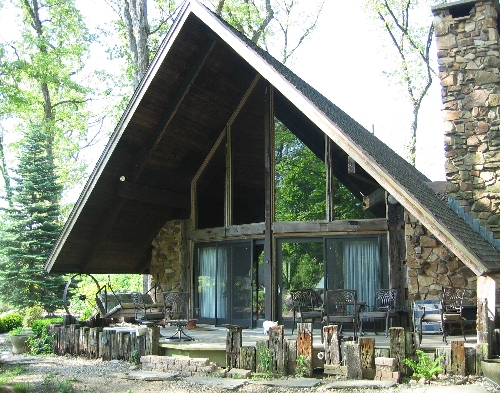
The A-Frame roof overhang which extends 10 feet beyond the living room floor to ceiling sliding glass doors, pictured above, is accented with more wagon wheels. It shelters the rustic front porch, its original custom-made outdoor barbecue—which is also visible on the right side of the earlier A-Frame photograph of the house—and the handmade porch swing made by Bill, which, understandably, he rarely had time to rest in.
Bill's custom-built stainless steel outdoor barbecue was five feet square with the barbecue pit in the center. Four 12 inch wood leafs folded up on all four sides of the barbecue, like the leafs on a drop leaf table, making it six feet square. Guests could sit around the barbecue, watch the food being grilled and be served directly from the grill.
The outdoor porch also provides a place to lounge and enjoy an impressive view of the three level Inspirational Water Garden and Gazebo, pictured below. They were installed recently by the third owners who contributed to its storybook history. Their landscape business was appropriately named, Inspirational Water Gardens.
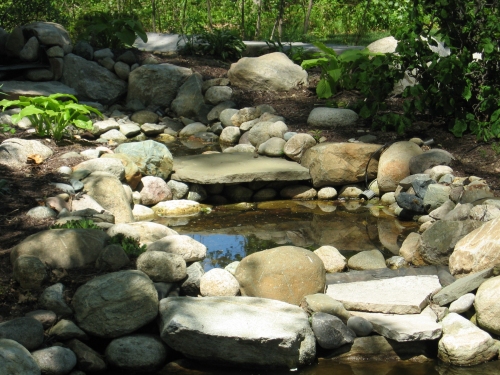
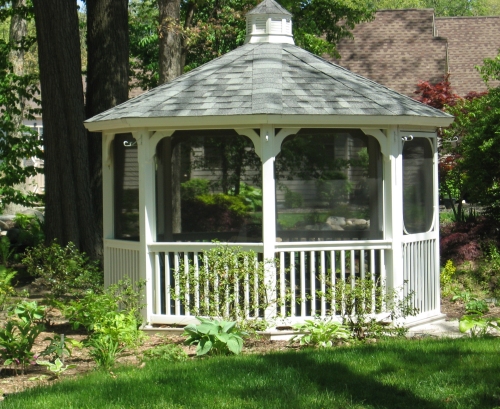
There will never be another home like it. It's a monument to one man's seemingly impossible dream, his individuality and unconquerable spirit. All of this was only a dream in his heart when I wrote his poem, That Unconquerable Spirit, so you can see how he inspired it long before his Dream Home became a reality
Every year a Christmas Tree transported from a farmer's woods graced their living room during the holidays and his wife cooked the family an eggs and bacon breakfast in an almost two foot antique cast iron frying pan which could cook a dozen eggs and weighed 26 pounds.
In the hallway entryway leading to the living room is the horse collar he made into a mirror and the glowing green ship lights he made into hanging light fixtures.
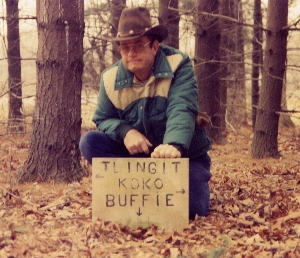
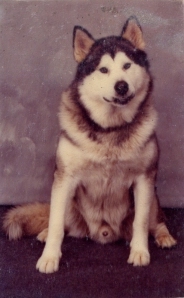 Centered above their garage door is a farmer's hay hook and track with Bill's Alaskan snowshoes mounted on each side of it. Close by are dog houses and a dog run for their two Alaskan Malamute dogs, Tlinget and Koko, who kept an eye on things. They produced five litters of Malamute puppies which their boys raised, while their daughter, Kelly, and Michelle, one of her school friends, raised goats and exhibited them at 4-H fairs.
Centered above their garage door is a farmer's hay hook and track with Bill's Alaskan snowshoes mounted on each side of it. Close by are dog houses and a dog run for their two Alaskan Malamute dogs, Tlinget and Koko, who kept an eye on things. They produced five litters of Malamute puppies which their boys raised, while their daughter, Kelly, and Michelle, one of her school friends, raised goats and exhibited them at 4-H fairs.
When their Malamute dogs, TLINGIT and KOKO, and their Poodle lap dog, BUFFIE, passed away Bill carved a tombstone for their graves in a grove of trees near their dog houses.
Along the driveway leading to his garage door entryway is a bright red antique gas pump rescued from a farmer's barnyard. Bill wired its globe and glass top—where the gas was once stored—as a post light which illuminated their driveway entryway for nighttime visitors.
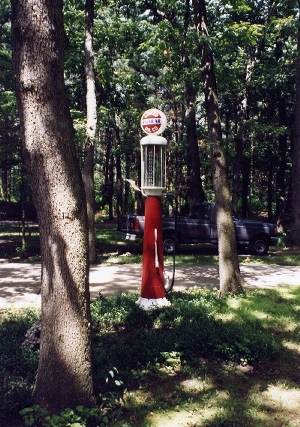 Over the years, they took family traveling vacations in what Bill called his Mushroom Van. He designed and built the interior as a camper and had a friend paint flamboyant, eye-catching mushrooms, toad stools, frogs and butterfly designs on the bright mustard-colored exterior. It was definitely a one-of-a-kind, show-stopping, attention getter, on the road and wherever they stopped to camp. A friendly conversation starter that made many new traveling friends for them wherever they went.
Over the years, they took family traveling vacations in what Bill called his Mushroom Van. He designed and built the interior as a camper and had a friend paint flamboyant, eye-catching mushrooms, toad stools, frogs and butterfly designs on the bright mustard-colored exterior. It was definitely a one-of-a-kind, show-stopping, attention getter, on the road and wherever they stopped to camp. A friendly conversation starter that made many new traveling friends for them wherever they went.
Throughout their growing up years their family of five traveled 186,000 miles through three different countries in their Mushroom Van, exploring and photographing, every National Park from ocean to ocean. And Bill was always proud to say that it had a toilet paper oil filter and in all that time they never had to change the oil.
When it was too old to travel long distances, it became Bill's work van and was a familiar sight for years on every construction job he worked on—many of them on the University of Notre Dame campus—attracting waves, winks, and curious smiles even in its old age. With a little imagination one can appreciate what it looked like when it was new and eating up the miles on their family travel trips. It wouldn't surprise me if a few tears were shed when it was finally put to pasture as this farewell photo illustrates.
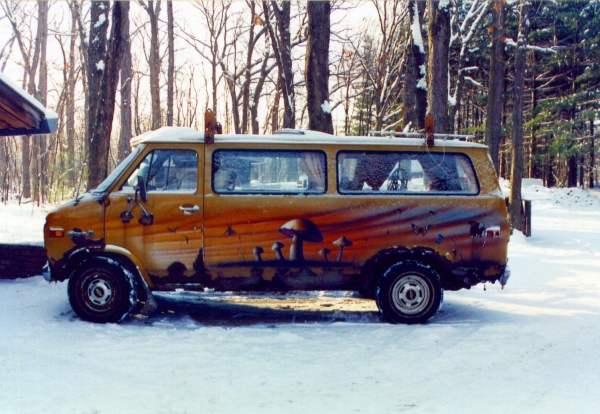
However, Bill's Mushroom Van was not alone in being retired. As their children grew up and began leaving the nest for college and careers of their own, their Dream Home was almost completed, and he was finally able to add the finishing touches at a slower pace.
Unfortunately, just when he was about to enjoy the leisure of the fruits of his labor, the unexpected and inexplicable happened. His wife decided to end their 28 year marriage. The Dream Home he had put his heart and soul into had to be sold and the marriage assets divided. It was a crushing blow, softened only by the knowledge that his labor of love would become someone else's Dream Home.
I still have the page printed by the realty company when they added it to their other listings. Under an attractive photograph of his A-Frame home, which I used at the beginning of this story, was this appealing description of it written by one of their realtors:
COME HOME TO YOUR PRIVATE WOODED RETREAT at the end of the day. Nestled among the trees at the end of a little lane is your haven from the world. Unique, quality built A-Frame custom built brick home on 6 acres in Clay Twp. Three BRS, 3 baths, vaulted great room & so much more. Don't miss this one! Call Cherie TeRoller for private showing.
It was such an appealing description that it warmed my heart to read it after all these years. And it is still a fitting description of Bill's Dream Home. I didn't expect to find the realtor still in town after all these years but never one to ignore an intuitive impulse, I decided to obey my nagging notion and see if she was still listed in the telephone book and if she remembered the house.
She did remember it and was so pleased to hear from me. She said she enjoyed meeting my brother and showing the house. So I told her the comment one of the other realtors she worked with made when I spoke to him about it. He remembered the house too and said he was also impressed with everything about it because it was so unique. But the thing he said he remembered the most, was the surprise he got when my smiling brother answered the door packing a pistol on his belt.
Shortly after Bill's A-Frame Home was listed, it was purchased by the family whose daughter, Michelle, was the school girl who raised goats with their daughter. So the Dickesons, who had been there during its construction, knew the enormous effort that went into its creation.
Fred Dickeson was a longtime employee, at the Lobund Laboratory on the campus of the University of Notre Dame, so he also appreciated the history of the Sorin land it was built on. When I met him recently, he told me that soon after they moved in his wife rented a Bobcat and proceeded to make winding paths through the six acres of woods for her daughter and her friends to explore.
Before turning his home over to its new owner—in the living room on the center beam between their floor to ceiling sliding glass doors—Bill added one last finishing touch for any and all future owners who might occupy his Dream Home in the years to come.
It was inspired by an old Spencer Tracy movie, filmed in the mountains of Switzerland. I happened to see it when my brother was preparing to pass his Dream Home on to its new owners.
In one scene in the movie, Spencer is invited to a rugged and rustic mountain cabin in a wilderness setting, aged with time and filled with memories. In the main room above the fireplace was a worn and weathered plaque dated in the 1800s. When I saw the movie it seemed the perfect finishing touch to suggest to my brother, Bill. I told him his Dream Home had one thing missing. Like a finished painting, it needed a signature, and I told him about the cabin in the Spencer Tracy movie.
Never one to let the grass grow under his feet, the next time I stopped by, Bill grinned at me mischievously, led me into his living room, and showed me this small antique brass plaque, with these simple words—like the signature on a painting—engraved on it:
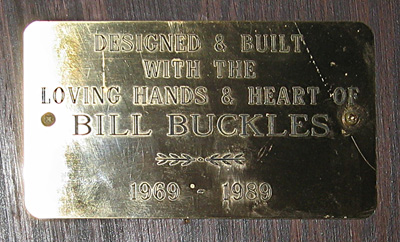
And so, with the arrival of its new owners, who now considered it their Dream Home, the fairytale house in its fairytale woods began to acquire its storybook history.
As the years went by, large plots of forest land surrounding Bill's former Dream Home and its six acres, were purchased by land developers who began clearing the forest land, along with its many historic trees, to build a community of upscale masonry homes in the area.
Each year they built more and more homes, swallowing up in every direction the huge forest that had once been there and coming closer and closer to Bill's A-Frame home, and its wooded six acres—now purchased by its new owners—until his six acres of oaks and pine trees became a wooded island amongst the rows of handsome masonry homes, now left with only an occasional tree, here and there, to decorate their small lots.
The developers soon became interested in the additional six acres around Bill's home so they could add more homes to the ones already nearby. They made an offer to the new owners of Bill's home to trade one of their new upscale show houses for Bill's house and it's six acres. They pondered the offer for some time and finally agreed to the exchange.
A large portion of the six acres of land around Bill's Dream Home was divided into additional lots to build more of their upscale homes, leaving Bill's woods and home still wooded but with only two acres now surrounding it. Using it for a club house was suggested by the builders but was turned down by the new community of home owners. It remained empty for several years and then was used, temporarily, by the contractor and his men, to be closer to their jobs.
Several more years went by, and every now and then I'd drive by—the house with nobody in it, in it's wooded island setting—just to be sure it was still there and had not been replaced by more new homes.
One day, in 2008, I was surprised to see a white gazebo peaking through the bushes and a man blowing leaves on the property. I couldn't resist stopping and asking him if he was working for the builder of the adjacent homes. No, the man replied, we just bought this house. As the saying goes, Be careful what you wish for. He went on to explain that they had looked at the house when it first came on the market in 1989. That it was their Dream Home, and they wanted desperately to buy it, but they were just starting out and didn't have the money.
When, by chance, almost 20 years later, they saw it empty, he said they approached the builder of the adjacent homes and were amazed that they were able to purchase it on the spot. When they learned I was related to the man who built the house they were eager to learn more about it. Shortly afterward, I put them in touch with my brother and they were thrilled to meet him in person.
They had just added the Gazebo and were in the process of completing the three level Water Garden when the 2009 economy crisis hit many businesses this past year. Due to unfortunate circumstances beyond their control, they were unable to keep their newly acquired Dream Home and it is now in the hands of another realtor waiting for a new owner.
Fortunately, I was able to get pictures of the front of the house, the gazebo, and the almost finished waterfall, before they had to leave.
Every now and then, I still drive by—the house with nobody in it—hoping to find it occupied once more. A nostalgic stroll around the almost completed three level water garden, recently, brought back a remembrance of another of my brother's planned historic additions to their six acre property had he been able to complete all of his future plans for their home.
Among the historic items of interest Bill acquired for his Dream Home was another seemingly impossible addition to their six acre plot of land.
Early in the building of his home, he learned that the Carriage House on the Studebaker estate was going to be torn down and sold for salvage. He stopped by just in time to get these two quick pictures of one of the arch entrances to the Studebaker Carriage House before it was dismantled and carted away to a salvage yard. He also made a quick sketch, to use as a diagram later, to put them back together.
The historic former Studebaker estate, Tippecanoe Place, has since become a popular upscale restaurant. It is believed that the grounds on which the estate was built were once a favorite camping site of Tippecanoe, the chief of the Miami Indians.
The photographs, below, show how the complete archway looked close up—with the doors still attached—before it was dismantled and hauled away. If those ancient stones could talk, one can only imagine the many ghostly memories they'd have to share, of days gone by.
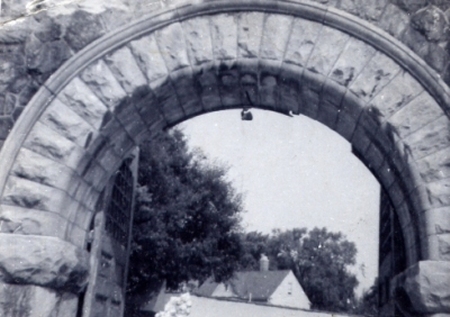
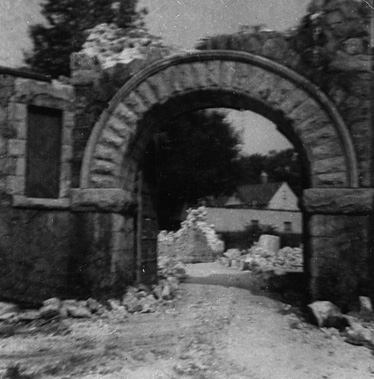
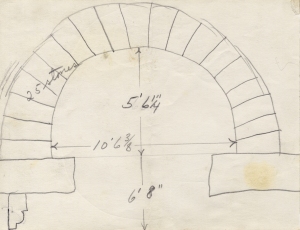
Always open to new ideas, Bill got the idea of hauling the 25 pieces of the arch to his property with the thought in mind of putting it back together as an archway entrance to his six acre wooded plot of land at the end of Kintz Road, which at that time, was surrounded by a thick forest of trees in all directions.
He waited until he heard the carriage house had been torn down, and traced the archway to HAM THE WRECKER'S salvage yard. He bought the 25 stone wedges for $74, which was a bargain, but then who else would have contemplated putting the arch back together? The cut stone wedges were trucked to his plot of ground and placed along the back fence line of their woods property until the house itself was complete and it could be added—like ranchers do out west—to identify the entrance to their property.
Bill photographed the arch and labeled the stones and their positions in the archway in the diagram above, fully intending to someday put it together again. In later years, in telling the story, he would often say, It will take a better man than I am to put it back together again.
However, previous owners did find the stone wedges in the woods one day and hauled them one by one to the front of the house to be used as a garden wall decorating their water garden. In walking among them, one can spot them easily, by the holes driven in the middle of each one of them. The holes were used to assist the masons in lifting the wedges to place them in position to form the completed archway entrance to the Studebaker Carriage House. Just viewing the photograph of the original archway and the workmanship that went into it, is impressive.
Interestingly, this part of the country was once, referred to as the Old Northwest. In the Treaty of Paris (1783), the Northwest Territory encompassed the area west of Pennsylvania, east of the Mississippi River, and north of the Ohio River to the border with British Canada. The Old Northwest, as the region later came to be known, eventually included the states of Ohio, Indiana, Illinois, Michigan, Wisconsin, and the part of Minnesota east of the Mississippi River.
Kintz Road, which is a mile north of Notre Dame is named after the Kintz family who sold Bill his six acres. Their family goes back to the days when Notre Dame was founded. Many descendants of the family are still associated with Notre Dame. Elmer Kintz, who sold six acres of his property to Bill, was the superintendent of the building of the Athletic and Convocation Center. A portion of the Kintz family farm is still on Kintz Road and is being farmed by a descendent of the Kintz family.
Many years passed as Bill's home progressed toward completion. The stone wedges lay hidden in the weeds, unnoticed and pretty much forgotten along the fence line. In the meantime, in the midst of digging a large hole for their septic tank, Bill unearthed a huge impressive boulder—left there during the ice age—which put a halt to any more digging.
Bill's friend, Ernie, once again, brought his crane to get it out of Bill's way. When he hauled it out of the hole and set it down on the ground, it rested nicely on one end. It weighed 1300 lbs. Not knowing where to put it, Bill decided it would make a perfect temporary marker—to show visitors where their property line began—until he could position the archway entrance when the house was completed.
He stenciled his name and house number in red on the huge rock. Much time passed and the archway stones faded from memory. Yet, even now, though the land has changed hands, the huge boulder still proudly announces its former owner's presence—if only in spirit—as if he were still there.
It remains there to this day, as you see it in the picture below—with two upscale masonry homes, pictured nearby—because moving the huge boulder, even now, would probably be more trouble than it was worth for the realtor. A few scratches here and there over the years seems to indicate an attempt may have been made to remove his name, but to no avail. Perhaps it will always be there, standing guard over what was once meant to be the archway entrance to the six acres of woods that once surrounded Bill's Alaskan Homestead.
In the picture below, the woods you see—between the two homes—conceals the little lane within the two acre wooded island which still encircles Bill's Dream Home.
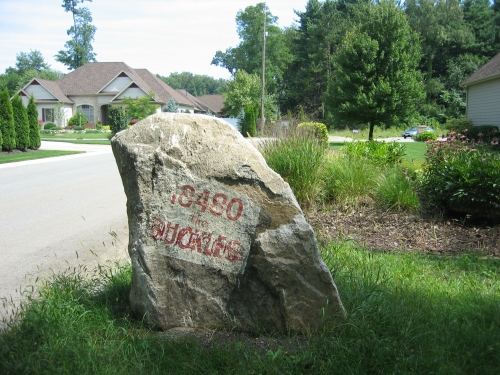
This excerpt from a recent Architectual Digest article by Michael Frank, has given me hope that maybe sometime in the future Bill's Dream Home will, once again, find just the right owners to appreciate the heart and soul that went into it:
I hope I'm around when it happens. But if I'm not, hopefully this story about, THE FAIRYTALE HOME—IN THE FAIRYTALE WOODS—WITH A STORYBOOK HISTORY, will still be out in cyberspace for website readers and any future owner's and their descendents to enjoy.
Times may change, and new owners may come and go, but one thing I'm certain of, my brother's spirit will always be there because he put his heart and soul into it.
True to his nature my brother took the loss of his Dream Home on the chin. Shortly after his home was sold he found a little bungalow, built in 1920, on a large lot near the airport with several large trees on it and proceeded to put his heart and soul into it. He renovated it from top to bottom. The large double garage was his workshop with plenty of room for a new and larger Goldwing Honda motorcycle. He added a big picture window in the dining room overlooking a huge tree loaded with his elaborate handmade one-of-a-kind feeders for birds, squirrels and chipmunks who put on endless shows to entertain visitors.
Now that he was single, Bill hit the road again on his own and the motorcycle wanderlust has never left him. It has been his main road vehicle at home and wherever his fancy takes him. Always traveling with his current lap dog or stuffed monkey (pictured in the last motorcycle photograph below) riding in the jump seat along with him. Currently, it's a Shihtzu named Jersey. The Mountainous west has always been one of his favorite stomping grounds. He never tires of seeing new places and meeting new people.
When I sent Bill's son, Troy, a sample of this website story to approve before it went online, he shared this heartwarming remembrance of one of their many cross country family travel trips:
Your story reminded me of the summer that dad was out of work and decided to take us on a 6 week vacation in the mushroom van. We covered too many National Parks to count. Dad always said he wanted to educate us on "what else was out there" and give us an idea what the rest of the country held so that when it came time to look for jobs and a place to settle down we would know what was out there. I think it was his way of encouraging us to venture out and it's probably what led to me taking my first real job in Texas and Shane taking his in Colorado.
Dad also took us on an Alaska cruise, in May of 2000, I believe. It was a couples trip with Cheryl and our wives for him to show us all Alaska and why he loved it so much. We took another couples cruise in 2005 to Barbados from Florida with all six of us. Dad always wanted to go back to Alaska one more time, but his health didn't last long enough to get that trip in.
Troy also shared this interesting story when he saw the Goldwing motorcycle in the photograph below:
He said the first motorcycle in the row of motorcycle photographs, below, is actually a picture of his Dad on an antique Goldwing that he purchased to give to Shane. The one pictured is a '75 or '76 model, one of the first years for the Goldwing model. When his Dad came across it he couldn't pass it up. He rode it from Indiana to Colorado to give it to Shane in person, probably the day this photograph below was taken.
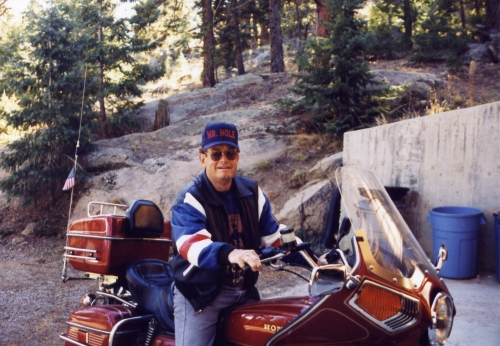
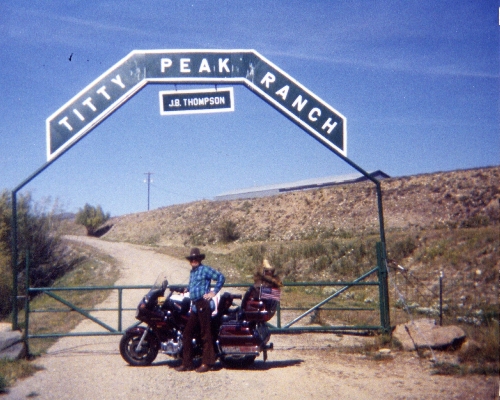
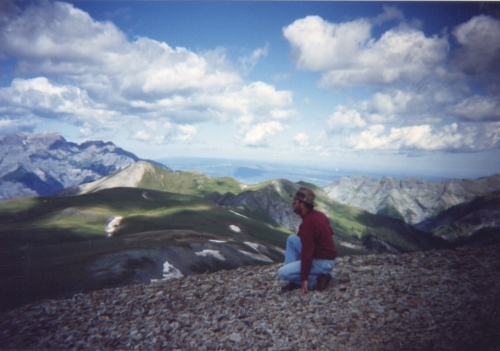
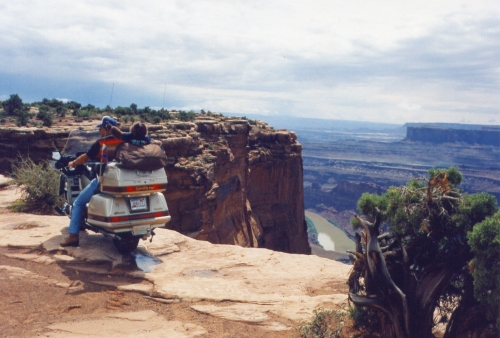
He seems to live by that old truism: Go out on a limb, that's where the fruit is. He has always lived life on the edge as if he were saying: Here I am fate, if you want me, come and get me. But so far, I guess fate isn't ready for him.
Yet, he has survived several major motorcycle accidents, one in Mantane, Quebec, Canada near the St. Laurence Seaway, totaled his new Goldwing motorcycle, pictured above, when someone ran a red light. Cheryl was riding with him. His hip was broken in 3 places and she had 18 screws in her feet. After spending a week in a French speaking hospital, they had to return via a private plane because Bill could not sit up to fly home on a domestic flight. Nonetheless, injuries never seem to slow him down.
As brother and sister we are poles apart in lifestyle, but we share a mutual admiration because we are different from one another. I marvel at the way he grabs hold of an idea and won't let go until he's got it in his hands. His is the kind of spirit that built this country and he shares that in common with those early pioneers who had three things going for them – God, Guts and Get Up and Go.
However, giving up his Dream Home was not the last cloud on my brother's horizon. After twelve years in their home near the airport, which he had renovated from top to bottom, lightning struck again. The land near their 1920 bungalow—and the land of many other homes around them—was being purchased by the city for future expansion of the South Bend Regional Airport Industrial Park. They read the writing on the wall. It was time to look for another home.
They now live in a comfortable ranch house in the Amish country in Bourbon, IN, where Cheryl comes from and near where she works, which in many ways is tailored made for them now that Bill is retired.
In 2008, I received an email from two contractors in the east who were commissioned to build a $300,000 replica of Notre Dame's Grotto at a Catholic boy's school in Wilmington, Delaware. In looking for information about Grottos on the Internet they found my website about Notre Dame's Grotto and the St. Stanislaus Grotto. They contacted me by phone and asked me if I could show them the Grotto at Notre Dame and arrange for them to take measurements of it.
They also expressed the wish to see the St. Stanislaus Grotto and speak to my brother since he was probably the only known living person who actually worked on a Grotto.
Typically, Bill, he made the 35 mile trip from his home in Bourbon to meet us and they all had a great time talking shop. They had never been to the Notre Dame campus before and were truly impressed and grateful for the weekend we spent together exploring the campus. The owners of Bill's Dream Home, at that time, also gave them a tour of it and they were equally impressed. Several weeks later, they emailed me an update on the progress of their project and included an impressive watercolor painting of their proposed Grotto and an invitation to be there at its dedication.
I still look at the Alaskan Homestead my brother created entirely with his own two hands and wonder how he did it all. I'm sure he does too. Perhaps this poem he inspired, says it best:
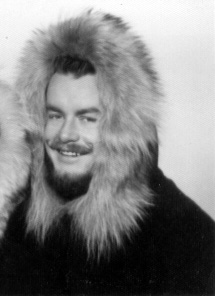
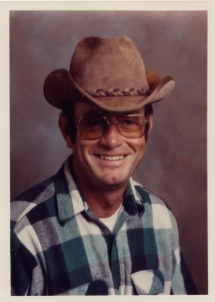
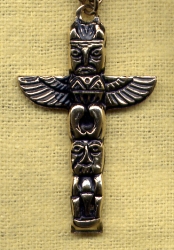
This narrative would not be complete without sharing this heartrending conclusion:
In the summer of 2008, Bill faced a third cloud on his horizon. Lightning struck again. This time with unexpected and deadly consequences. He was diagnosed with Malignant Melanoma in his lungs, which eventually spread to his brain. He's been through radiation and chemotherapy and has been facing almost insurmountable odds all during the time I've been writing this tribute to him.
On the last trip he made to Snake River, in 2008, he was weakened by his treatments but insisted he wanted to make one last whitewater rafting trip with Shane on the Snake River. That was when Bill proclaimed: If I'm going out of this world, I'm going out in style. When they were dumped out of the plastic "duckie" canoe they were in, he said it was the closest he ever came to drowning. A photograph of them was taken just before their canoe capsized. It's the last Snake River rapids photograph shown at the beginning of this story.
In February of 2009, he was given six months to live.
An MRI taken a few months later showed a slight improvement. When another MRI was taken in early August 2009, Bill shared the news with me over the phone, at the exact moment I was putting the last finishing touches to his story.
To our wonder and delight, his Doctor told them THE CANCER TUMOR WAS NO LONGER THERE! It looked like he had beaten the odds! Relieved and pleased, I was looking forward to seeing him regain his vim and vigor, knowing, if he survived this close call, he would undoubtedly be looking forward to celebrating life, once again, by challenging the Snake River Rapids the first chance he got.
Unfortunately, our high hopes were dashed when a week later an additional CT-Scan was taken and they discovered the cancer had spread to other areas not detected by an MRI. The CT-Scan showed areas that were not visible in the MRI.
His condition steadily declined but he wouldn't give up. He kept on the move meeting his buddies for breakfast every morning although it must have been an immense effort on his part. It was his way of coping with his weakening condition, when he'd been strong and healthy all his life. One day he called me and said, Hey Dot, guess what. I went to a bricklayer's breakfast this morning. I was sitting next to a bricklayer I've worked with all my life and he didn't recognize me. It was heartbreaking to see him trying to cope with an invisible adversary.
As his condition worsened he was sent to Memorial Hospital in South Bend where they determined that the cancer had spread so rapidly that his condition was now beyond medical help and they would be stopping all treatments.
As his condition steadily declined, he was sent to Hospice House where they provide humane and compassionate care for people in the last phases of incurable disease. Terminal patients and their families are treated with the upmost care and kindness so the patient has a pain-free quality life, making the best of each day during the last stages of advanced illness. It's a caring atmosphere you feel the moment you enter the facility.
On my first visit, Bill appeared to be sleeping, eyes always closed and no sign of any kind of verbal exchange when I spoke to him. On my second visit, his wife, Cheryl, and I were quietly conversing. When I got up to leave, I walked over to his bed, stroked his forehead, and said to him: Bill, this is Dot. You are my inspiration. We love you. Still no response.
As I turned to leave his side, I noticed his hand moving slightly under his blanket. Cheryl walked over, pulled the blanket aside and said, He's reaching for your hand to let you know he knows you're here. I put his hand in mine and pressed it gently in reply. It was a moment I'll always cherish. And I was so grateful to Cheryl, who in being with him constantly, had interpreted his movements.
I was still feeling the warmth of his touch on my way to the car, when a long ago past remembrance of Bill revisited me in my thoughts. He had just returned from a motorcycle trip out west and stopped by our home to surprise me with a gift he said he bought with me in mind. When he handed me the small box, he grinned, and said, I thought of you when I saw this, Dot. I thought you might like to have it.
Inside the box was a delicate sterling silver pendant on a gleaming silver chain. I'd never seen anything like it before. When I asked him what it was, he said it was an Indian Dream Catcher and he explained the Indian folklore behind it. That it was believed to give the owner good dreams.
I was captivated. He had no way of knowing, that at that very moment, I was in the midst of researching the Indians on the campus who were once a significant part of the early history of the University of Notre Dame. I grinned back at him with pleasure and told him it was perfect for me because I had caught a lot of dreams throughout my life, and most especially, during my historical research on campus.
I always wear it now, along with my Lourdes Medallion, at all my A Cave of Candles book signings. So I was wearing it the second time I visited Bill at Hospice on my way home from a recent football weekend book signing on campus.
Remembering that long ago day he stopped by with my Dream Catcher, brought to mind another poem his Dream Home inspired. It was written in 1968, the same year I wrote his, That Unconquerable Spirit, poem.
I called it, Always Have a Dream, and I illustrated it with a photograph of the Indian Dream Catcher he purchased at an Indian Reservation on one of his motorcycle trips. It is the illustrated the poem below. I can picture him now, on his Goldwing motorcycle, joyously winging his way back home on a blue sky, cloud filled, warm summer day.
I was reminded of that poem again, during my most recent visit to Hospice to see Bill. To my surprise, his best friend, Ernie Snider, the crane operator, was there from Florida to be with him. We greeted each other with mutual pleasure, for the first time in many, many years.
He told me he had just read the printout of Bill's story I had written, which his boys had left in his room, and he was thoroughly enjoying remembering the good old days when he helped Bill build his Dream Home. He smiled when I told him that I couldn't have written it without Bill's help. That when he was still able to, he sent me the photographs to scan and told me about his adventures in Alaska over the phone.
Bill's sons, Troy and Shane, were hoping to be able to read it to Bill, but unfortunately that was not to be. In spite of my burning the midnight oil nightly, I wasn't able to finish it in time. Don't worry, my son told me, it will be there for his family and friends.
When one of the nurses needed to tend to Bill's needs, Ernie and I moved to a small sitting room to continue our conversation. We both agreed that Bill was one-of-a-kind and there would never be another one like him. Ernie told me that Bill loved to feel the wind rushing by on his motorcycle trips. And on warm sunny days he would often ride shirtless, in shorts and flip flops, and without a helmet.
Ernie shook his head and smiled in remembrance of Bill's reply when he voiced his opinion of Bill's risky attire. Ernie said he told Bill that One of these days he'd take a spill and crack his head open like a coconut. Ernie said he would never forget Bill's grinning reply: Well, we all gotta die sometime.
We were both smiling during that conversation, visualizing Bill in his summer attire. Yet, we both had to agree, regardless, Bill had packed more adventure and fun into his 75 years than anyone else we knew.
Ernie, who was Bill's lifelong friend and motorcycle buddy, told me he would never forget the first thing Bill said when he telephoned him, early on, to let him know about his latest stay in the hospital: I'm fixing to take my last big ride, Ernie, and I wish you were going with me. It touched my heart. It was so like Bill.
That same day as I was leaving, I went over to Bill's bedside, as usual, to hold his hand in mine before I left. I wanted to tell him I had finished his story, but again, I did not expect a response. The one I got warmed my heart. To my surprise, he murmured two words, That's good. Later that same day, Cheryl told me over the phone, that she was straightening Bill's covers when he looked up at her lovingly and said: I'll be waiting for you on the other side.
Bill was not a passive person. He was never one to mince words. He said what he meant clearly and directly. He called a spade a spade and when he saw someone behaving like an idiot, he'd tell them.
His, Never give up ... No matter what, philosophy keeps ringing in my ears. The words of Dylan Thomas to his dying father come to mind: Do not go gentle into that good night. Rage, Rage against the dying of the light.
It has been said, Spend your life on something that lives after you. Bill settled down and raised a family. He lived in and worked on the Alaskan Homestead he built for himself and his family for twenty years. He spent his life on something that will live after him. The world will be a better place because he was in it.
God willing, someday, his Dream Home will find just the right people to bring it back to life. And it will continue to be loved and cared for by future owners for decades to come. May this poem Bill's Dream Home inspired, Always Have a Dream, nurture your own dreams and brighten the corner where you are.
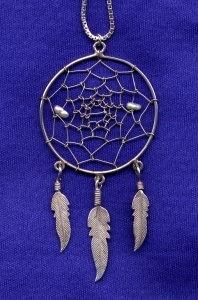
William Howard Buckles, 75, lost his battle with cancer on September 16, 2009. This tribute to him went out in the world on the Internet the day before, on Tuesday, September 15, 2009. The sequel, below, was written shortly afterward. It was inspired by the "Celebration of His Life" service his sons created in fond remembrance of their Dad.
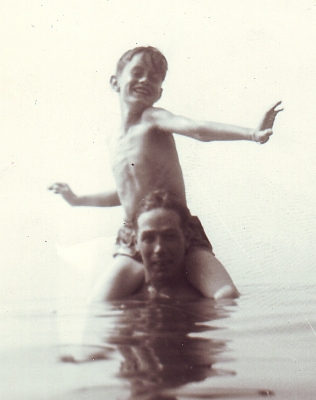
Bill was born on July 5, 1934. He served in the Army and was a bricklayer in the South Bend area for 50 years. He was a true adventurer and lived life to the fullest. When he was stationed in Alaska, he fell in love with the Last Frontier and when he came home to stay he fell in love with the adventure of touring America's National Parks with his family. He enjoyed skydiving, scuba diving and touring the United States and Canada via motorcycle and whitewater rafting.
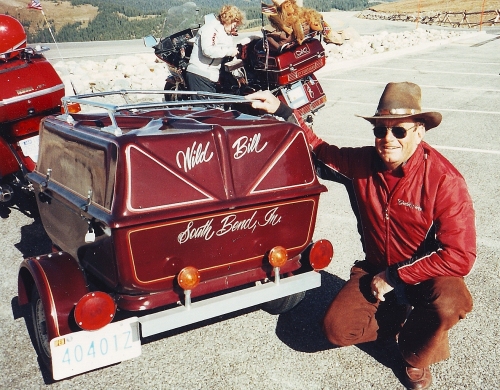
His sons remember well one of the stops they made at the Grand Teton National Park during the six week family trip they took visiting all the National Parks in the West. His sons plan to journey there again, next summer, in memory of their father, because he loved Lake Solitude the best of all their travels. Troy shared with me his memories of that first trip:
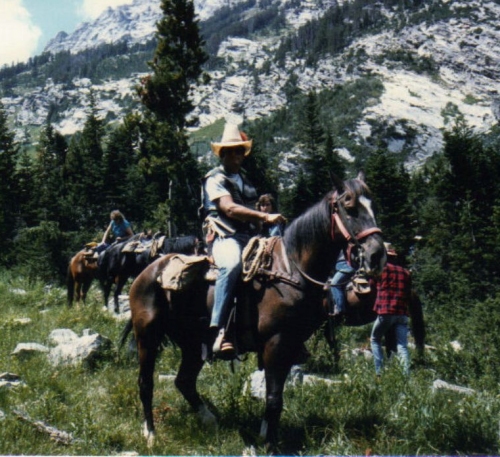
In those days, there was an outfitter that offered one-day horseback trips from Jenny Lake Lodge to Lake Solitude. Dad paid what I'm sure was a small fortune to rent the horses for this trail ride and led our whole group to Lake Solitude, a 20 mile round trip.
We stopped and had lunch at Lake Solitude before the return trip down the mountain. I remember how impressed dad was with the beauty and tranquility of this spot.
In addition to the great ride and spectacular scenery, we had the added entertainment of watching a self-proclaimed horse expert that was part of our group get bucked off her horse on the trip back. This woman hadn't stopped talking the entire trip and was giving everyone else advice and direction. Between the story of this woman getting her just deserts and dad reminiscing about how spectacular the views at Lake Solitude were, I think we heard about this trip every year from then until now.
In recent years, the park has banned horseback traffic on the trail to Lake Solitude and the only way to get there is by backpacking on foot. The backpacking trail is listed as 18.5 miles round trip. I'm sure that when we make our trip there, we will get a back country permit and camp overnight near Lake Solitude so we can take the time to relax and enjoy it again in memory of our Dad.
Four of the photographs below, and their descriptions, are from a very impressive website created by Jim Steele titled: The Mountain Goat, my hiking adventures. In it, he describes in detail The Paintbrush Divide – Lake Solitude Loop trail and many other trail adventures he has experienced firsthand in exploring the Grand Teton National Park. I highly recommend his website to anyone who is interested in learning more about the Grand Tetons. Jim very kindly gave me permission to illustrate my brother's passion for Lake Solitude with these photographs from his website.
For more detailed and exciting descriptions and photographs of Jim's Grand Tetons backpacking explorations and adventures go to his website The Mountain Goat. For his segment on the Paintbrush Divide – Lake Solitude Loop trail click here. His name, Jim Steele, The Mountain Goat, is fitting for this dedicated backpacking hiker, who must have nerves of steel and a great love for nature to faithfully venture into the risky and exciting unknown—in search of the wonders of the natural world.
From Paintbrush Divide, you descend down the walls of upper Cascade Canyon to Lake Solitude; it's about 2.4 miles. Lake Solitude is one of the most pleasant backcountry lakes in Grand Teton National Park. It's near the end of the North Fork of Cascade Canyon, so you'll be surrounded on three sides by the walls of the canyon. On the fourth side, just beyond the canyon, the Grand Teton looms. The setting is gorgeous and the canyon is pristine at 9,035 feet. — Jim Steele
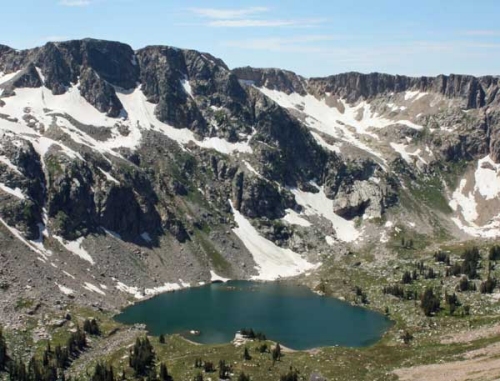
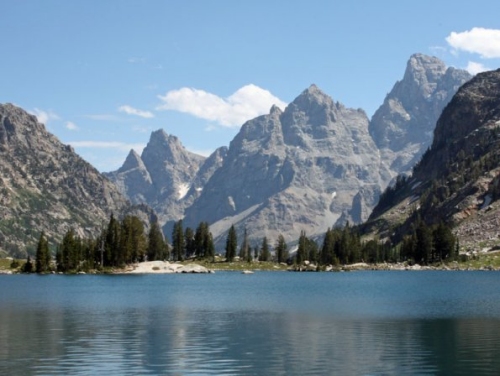
Lake Solitude just might be one of the most gorgeous places on earth. Many people stop at the south shore and see the lake against the end of Cascade Canyon. This picture is from the north shore looking down toward the Tetons, and I think that scene is even more spectacular. — Jim Steele
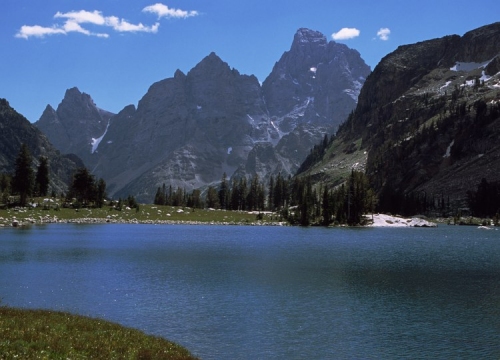
If you have stood and looked across the Cascade Canyon weaving its seamless way toward the summit of the Tetons you will know the joy of being in a sacred place designed by God to be protected forever.
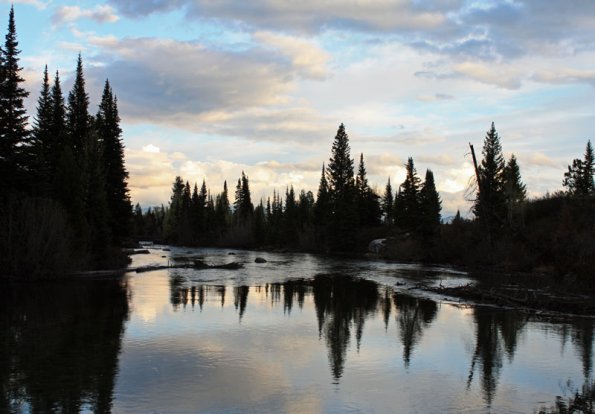
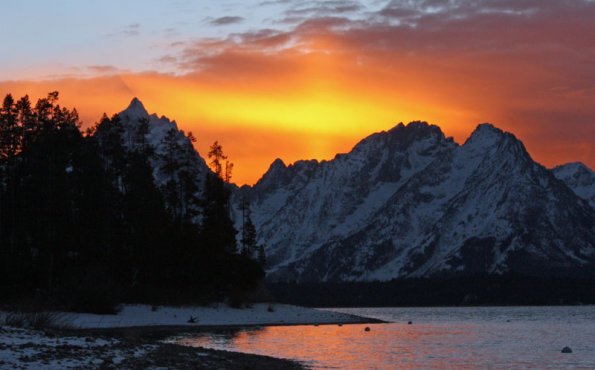
For me, I would like to believe that leaving this world would be like closing my eyes to the memory of the beauty of scenes like these. Believing that I will awaken on the other side to an equally glorious sunrise in that other world beyond this one.
I know now why Bill wanted to end his days on earth at Lake Solitude, a peaceful oasis of beauty among the Grand Tetons, and why he told his wife, Cheryl: I'll be waiting for you on the other side. Bill's glowing description of the spectacular beauty of the Northern Lights he saw in Alaska, must have been for him, his own personal glimpse of Heaven.
I'm also sure that Jim Steele would appreciate knowing that my brother Bill's whole adventuresome life was built around this favorite motto he often shared throughout his life. He shared it with my son and I when my husband passed away after a lengthy illness:
Bill's memorial service was an evening to remember. It was truly a celebration of his life. With photographs taken throughout his lifetime. The hall and parking lot, which included a long row of motorcycles, was full. Like Bill, it was a one-of-a-kind evening. Shane's memories of his Dad when he was growing up were priceless and when he invited Bill's many bricklayer friends to share their stories about his fun-loving nature, Bill's spirit was so powerful in every remembrance shared, that I doubt there was a dry eye in the place. Laughter and tears flowed.
I can just imagine, Bill, watching from above all that was going on that evening—and like his favorite motto—hollering: Holy Cow, what a way to go!
The Bricklayer's poem, below, which I had never seen before, was placed inside an illustrated memorial card given to everyone who attended. The Gaelic Blessing below it was so appropriate for Wild Bill who loved to be out on the open road riding his motorcycle wherever his fancy took him.
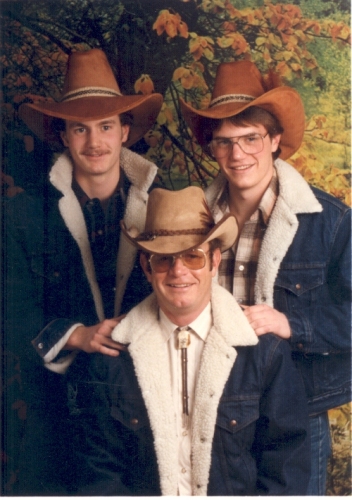
|
I do not choose to be a common man. It is my right to be uncommon All this is what it means to be an American. An American Statesman |
Bill's sons found this, THE AMERICAN'S CREED, in their father's treasured keepsakes. One need only know his life story to know what it meant to him to be an American. He lived all his adult life by this creed.
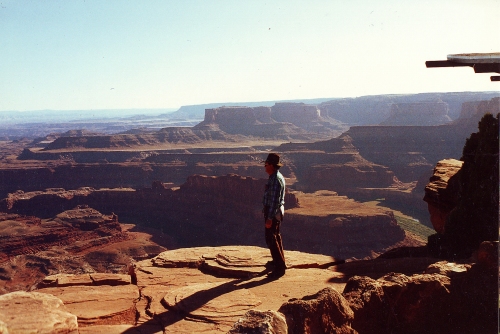
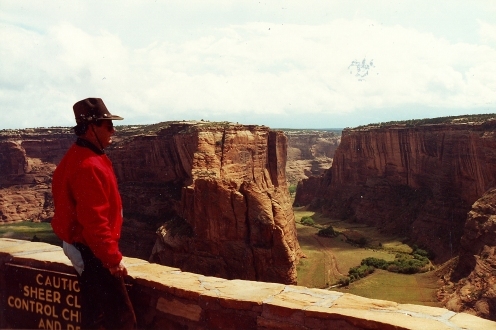
Earlier, in my conclusion, I mentioned that Bill's sons planned to journey with their families to the Grand Teton National Park this summer with Bill's ashes because he loved Lake Solitude the best of all their travels and he always said he wanted to end his days there. I'm sure that when we make our trip there, we will get a back country permit and camp overnight near Lake Solitude so we can take the time to relax and enjoy it again in memory of our dad, Troy wrote in an email.
Bill's son, Shane, sent this first email about preparations for their recent trip: I wanted to let you know that we will be leaving in the morning for Glacier National Park and the Grand Tetons to scatter dad's ashes. We are meeting Troy on Sunday in Glacier for a few days of sightseeing and then will be heading to the Tetons next Friday. We will be on the trail to Lake Solitude on 8/1 and will arrive at Lake Solitude on 8/2. We will take time to find the perfect spot to scatter his ashes, and per dad's request, Will, (Bill's grandson), will play TAPS. We leave Lake Solitude the afternoon of 8/2 and should be back at the lodge on 8/3. It has been a long time coming and it's hard to believe the trip is upon us. I will touch base again when we return from our trip.
Troy's email written on their return trip describes their journey: I'm in the back of our van checking e-mail as we drive into Nebraska on the way home. We're finally back into civilization and have an internet signal again. Thought you'd like to know that everything went very well. We had a beautiful, sunny day when we got to lake Solitude. It was quite a hike. There was a noticeable change above 9000 feet and we were all exhausted, but we all made it to the top. It was a three day trip, 21 miles hiking and over 4000 feet of elevation gain with our backpacks on.
Shane read the Indian poem that dad liked and Will played TAPS (didn't miss a note). Everyone had a turn to say something about dad if they wanted to. We scattered his ashes about 9:20 am Mountain Time on August 2nd. The view is facing SE, so he can look SE into the valley or NW toward the lake. I remember now why he chose that spot. There is something beautiful to see in every direction. I think you'll appreciate the poem when Shane forwards it on to you. It was very 'dad' and a nice tribute. We will probably be home Saturday night.
Shane: I think Troy summed up our trip very well, we couldn't have asked for better weather or a better outcome for our trip. Dad's final request really was a gift to our families and the time we were able to spend together. Below is the poem that I read at Lake Solitude. Dad and I never discussed the poem but I thought it fit well. Dad picked a beautiful spot and we felt his presence the entire trip in the Tetons.
Below is the poem and a photograph of Sunlight on Ripened Grain to illustrate it. I discovered it during a photographic search on the internet. It was taken by Petra Oolders. To see her beautiful Welcome To My World photography website from the beginning, click here.
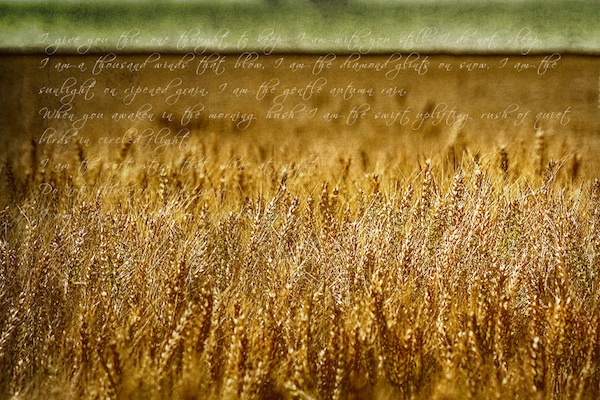
Troy continues: I'm not driving again so I get to surf the internet for a while. We scattered dad's ashes about 9:20 am Mountain Time on August 2nd. The picture below the video was taken about 10 am. All 8 of us gathered in a semi-circle on the grassy area in front of the trees in the picture. Shane had split dad's ashes up into 8 separate baggies so we could each carry part of him with us on the hike. I thought that was a nice, symbolic idea.
When it came time for the scattering, Shane read his poem after which I gave thanks for our time with dad, everything dad had done for us, and the example he had set for Shane and I growing up and his grandchildren. Carol added a thank you for the gift he had given us in the form of this trip and the family time together we were enjoying. When everyone had finished speaking we scattered dad's ashes, each in our own way. Shortly thereafter, Will, played a perfect TAPS on his trumpet which echoed beautifully down the canyon. He had carried it the entire 21 mile hike so he could play TAPS for Grandpa Bucky. Below is a YouTube video of it. The sound in the background is the wind.
The photograph below is the spot we chose.
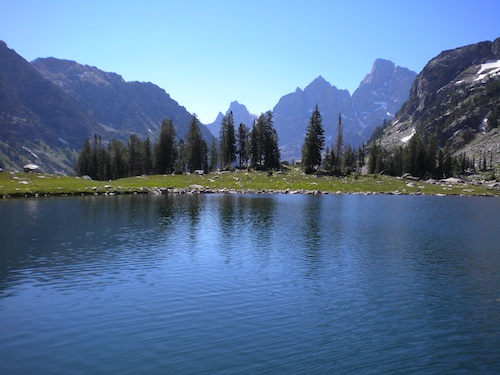
Dad's last wishes to be scattered at Lake Solitude, whether by design or chance, had led to Shane and I being able to spend two weeks together with our families. We had never been able to do this before and we thoroughly enjoyed each other's company. We both have been blessed with terrific wives and children and couldn't be happier. I guess this was dad's last gift to us.
Wild Bill Buckles has now arrived at his final resting place—Lake Solitude—his Heaven on Earth—nestled in a valley amid the majestic mountains of the Grand Teton National Park in northwestern Wyoming. His request to his family to scatter his ashes there, so he could end his days in his favorite spot on earth, is a lifelong gift from him they weren't fully aware of until they relived it afterwards. He has left them with a memory they will cherish forever and pass on to their own grandchildren. What a soul satisfying mission accomplished. Knowing Bill, I'm sure he was on Cloud 9 through it all, watching everything that was going on, and grinning from ear to ear. Perhaps he was also guiding Troy's hands when he took this last spectacular view of Lake Solitude, below, as they were leaving.
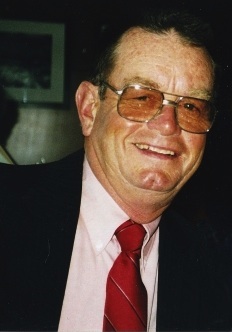
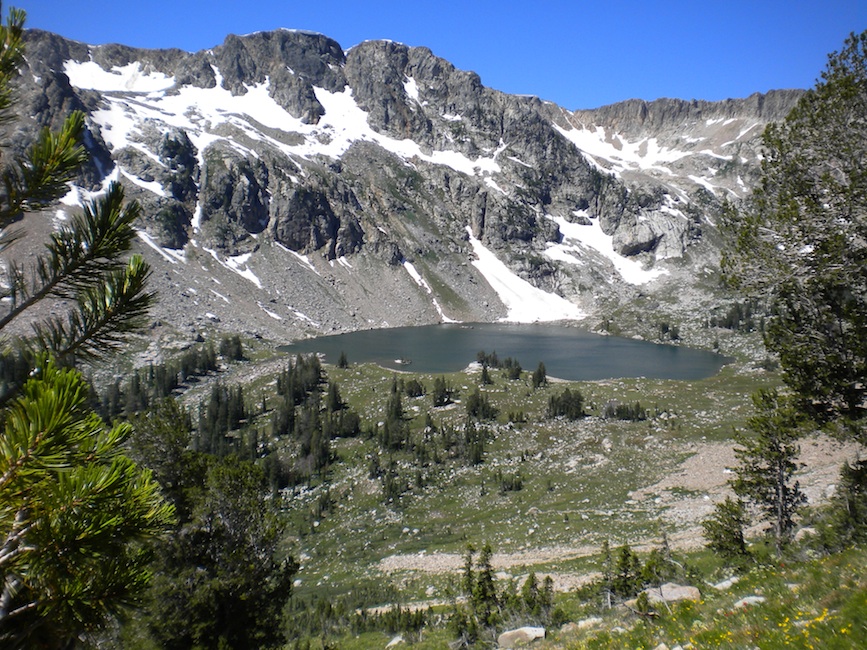
Bill was so right, his final resting place is surrounded by beauty in every direction. He even predicted this outcome earlier in his story: If I'm going out of this world, I'm going out in style! I'm sure this last photograph taken before they left will become a photographic memory that will warm their hearts and grace their homes as a a fond remembrance of their mission accomplished.
Perhaps these lines from The Sound of Music say it best: Climb every mountain, Ford every stream, Follow every rainbow, Till you find your dream! All we need is a dream in our hearts and the will to make it come true.
This one-of-a-kind Wild West photograph of my brother Bill, and his son, Shane, shown at the beginning of this tribute to him, has one last story to tell and I would be remiss in not including it. When Bill showed it to me in its frame on his wall—seeing I was intrigued by it—he gave it to me to scan and this story seemed to write itself from that moment on.

The small photograph, pictured below, of our dad dressed casually—with his everpresent pipe in his hand—was tucked into the lower right hand corner of the framed picture above. It tells a story in itself. I took the small photograph of our Dad from the corner of the picture frame first and decided to scan it as well.
When I removed the wildwest photo from the back of the frame to scan it, I was surprised to find a small piece of paper with a note on it, addressed to Bill's son, Shane, hidden behind the picture. It was dated 1988. I'm sure Bill meant it be a memento to go with the picture, a keepsake, Shane could pass on to his children.
Shane:
I look at this picture every morning and every nite on my dresser since 1988. It was a good trip to remember. We had a good time & I reminisce about it a lot. I wish there could have been more. — Dad
Below is a composite picture of the small picture of our dad and Bill's handwritten note to Shane:
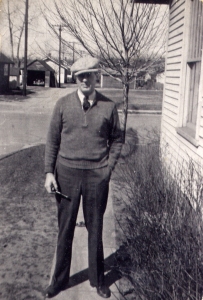
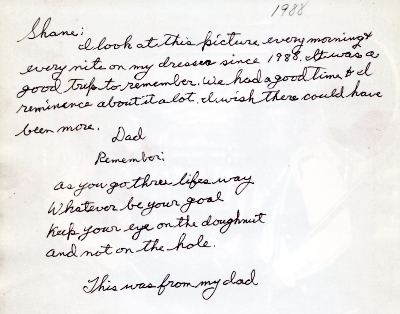
They say the world steps aside for a man who knows where he's going. My brother has always had his eyes on the road ahead, always going forward. Setbacks just fueled new ideas and new plans for the future. Father Edward Sorin was another of those men who had an unconquerable spirit. He always had his eye on the bright future he envisioned ahead of him. He never gave up on his dream to build a college in an Indiana wilderness. When his new main building burned to the ground and his statue fell to the basement he boldly proclaimed: I don't care if we lose it all! We will begin again! The priest who told that story, said it was like a grand pep talk between halves, long before there was any football at Notre Dame.
Father Sorin had his own kind of fearless determination and unrelenting courage in pursuing his goals in life. Because he dared to dream, a seemingly impossible dream, we can now enjoy the wonder of what has now become the University of Notre Dame and its beautiful campus. His example and his unconquerable spirit continues to inspire others who have come after him. They have fulfilled his mission far beyond anything he could ever have envisioned.
For more about Father Sorin and his vision, click on The Spirit of Notre Dame. You can also click on Notre Dame's Grotto for an illustrated website about the history of Notre Dame from Sorin's arrival, or you can purchase the same illustrated history in my book, A Cave of Candles, a published version of the history of Notre Dame from Sorin's arrival, in bookstores.
For those who would like to see the Sorin version of my That Unconquerable Spirit poem with a beautiful, colorful illustration of a clipper ship above it click on That Unconquerable Spirit
Fr. Sigmund Jankowski was another man who never gave up on his dream to build a replica of Notre Dame's Lourdes Grotto at his parish church, St. Stanislaus, in South Bend, Indiana. He also wrote a book about his beloved Notre Dame and how its Lourdes Grotto inspired him to build a replica of it at St. Stanislaus. He called his book: When Dreams Come True. In it, he mentions my father, William Buckles, Sr. who built it. When I met Father Jan, years later, he told me, my father was the only mason he could find who would tackle the challenge.
For the story behind the Grotto Fr. Jan built, click on Always Have a Dream
Note to my website readers: If my friend and poet, John Dougherty, or anyone who knows him, is out there somewhere in cyberspace, I hope they will let me know where life has sent him.